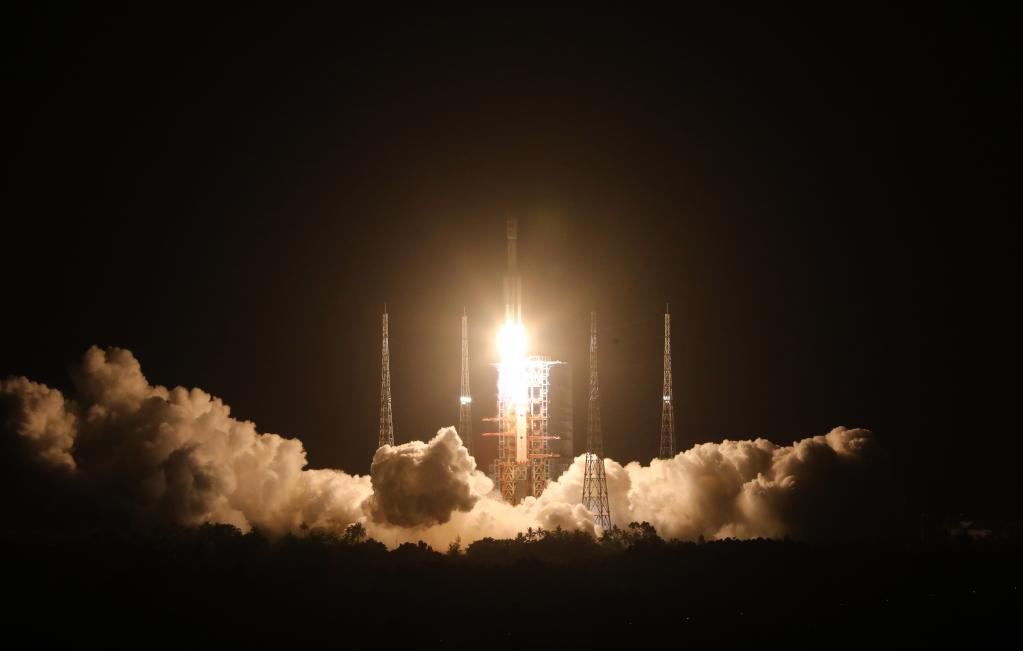China launches cargo spacecraft to dock with space station module

The Long March-7 Y3 rocket, carrying the Tianzhou-2 cargo spacecraft, blasts off from the Wenchang Spacecraft Launch Site in south China's Hainan Province, May 29, 2021. China launched the cargo spacecraft Tianzhou-2 on Saturday, which is scheduled to dock with the space station core module Tianhe to deliver supplies, equipment and propellant. (Xinhua/Ju Zhenhua)
WENCHANG, Hainan, May 29 (Xinhua) -- China launched the cargo spacecraft Tianzhou-2 on Saturday, which is scheduled to dock with the space station core module Tianhe to deliver supplies, equipment and propellant.
The Long March-7 Y3 rocket, carrying Tianzhou-2, blasted off from the Wenchang Spacecraft Launch Site on the coast of the southern island province of Hainan at 8:55 p.m. (Beijing Time), according to the China Manned Space Agency (CMSA).
After 604 seconds, Tianzhou-2 separated from the rocket and entered its designated orbit. At 9:17 p.m., the solar panels of Tianzhou-2 unfolded and began working properly.
The launch was a complete success, the CMSA said.
China launched its space station core module Tianhe on April 29. The country plans to complete the verification of key technologies and the in-orbit construction of the space station through multiple launches within two years.
Saturday's launch was the first time that the space station cargo transportation system, composed of the Tianzhou spacecraft and Long March-7 rockets, was put into use.
Measuring 10.6 meters in length and with a maximum diameter of 3.35 meters, the Tianzhou-2 cargo ship has a maximum takeoff weight of 13.5 tonnes and carries 6.8 tonnes of goods and materials.
More than 160 large and small packages, including supplies for astronauts and space-science equipment, and two tonnes of propellant have been loaded into the cargo freighter, according to the China Academy of Space Technology (CAST).
Lei Jianyu, a designer of Tianzhou-2 at the CAST, said that only two types of cargo spaceships currently in service globally have a maximum carrying capacity of more than 5 tonnes. "China's Tianzhou is one of them, and is at the world-leading level."
After docking with Tianhe, Tianzhou-2 will replenish Tianhe's propellant and help test equipment for space application projects.
The Tianzhou-2 cargo freighter is composed of cargo and propulsion compartments. Supplies are loaded inside the pressurized cargo section, and propellant in the propulsion section.
The propellant used for the Tianzhou-2's flight and the propellant for refueling the Tianhe core module can be flexibly distributed according to demand.
As the ancient Chinese said, to carry out an important task, supplies like rations and forage should go ahead of troops and horses. During the construction of the space station, cargo spaceships will always be launched ahead of crewed missions.
"We will transport support materials, necessary spare parts and equipment first, and then our crew," said CMSA Director Hao Chun.
Yang Hong, chief designer of the space station at the CAST, said that the launch missions of China's space station are closely coupled. Within 48 hours after Tianhe entered orbit, the core module underwent a status evaluation, and Tianzhou-2 then began its launch countdown preparations.
Following Tianzhou-2's docking with Tianhe, the Shenzhou-12 crewed spaceship will enter its countdown preparations for launch.
Three astronauts aboard Shenzhou-12, who will stay in orbit for three months, will unpack the goods stowed inside Tianzhou-2 to obtain their living and working materials.
In addition to supplies for three astronauts, the gear delivered by Tianzhou-2 also includes two spacesuits for extra-vehicular activities, each weighing more than 100 kg.
Tianzhou-2 is also delivering space food, dubbed "space deliveries" by Chinese engineers, including many traditional Chinese dishes.
From staple foods to non-staples, from meat to vegetables, the menu design is of high quality and appetizing for astronauts. Famous stir-fried Chinese dishes like shredded pork with garlic sauce and Kung Pao chicken are both on the menu.
Engineers have designed a special structure in the 18-cubic-meter cargo craft, dividing the interior into cargo compartments with honeycomb-like panels. Each compartment can hold several packages of different sizes, so that the packages can be efficiently placed in the compartments like building blocks.
To improve the efficiency of loading, the research team has made 26 types of packages of different sizes, including some in trapezoidal and wedge shapes to adapt to the cylinder cabin structure of the craft. In addition, they have developed safety locks, similar to those of aircraft seats, to hold the packages in position while in space.
The craft is also equipped with an information-management system. Each package has a label pasted onto it with a radio-frequency identification function, allowing the goods to be identified within a certain range.
Yang Sheng, a designer of Tianzhou-2 at the CAST, said that China's space station has applied the country's advanced logistics-management technologies, enabling astronauts to obtain the cargo location and information by scanning QR codes. With intelligent positioning, the astronauts can find and access the packages quickly.
The cargo craft will operate in orbit for one year. Its power supply capacity is not less than 2,700 watts. It can also carry out multiple in-orbit refueling missions.
"China plans to build the space station into a state-level space lab supporting long astronaut stays and large-scale scientific, technological and application experiments," said Zhou Jianping, chief designer of China's manned space program.
Photos
Related Stories
- China to launch Tianzhou-2 cargo spacecraft
- China's cargo craft successfully docks with space station module
- Fusion of science, art to illustrate sci-tech innovations
- China postpones launch of Tianzhou-2 cargo spacecraft
- China proposes solutions to develop and govern emerging technologies
- China mulls sending spacecraft to edge of solar system: scientist
- Chinese company launches prototype space mining spacecraft
Copyright © 2021 People's Daily Online. All Rights Reserved.










